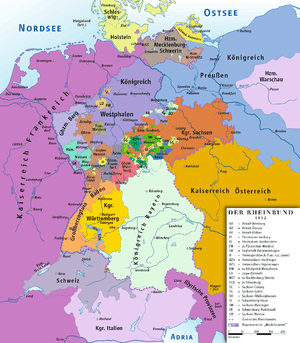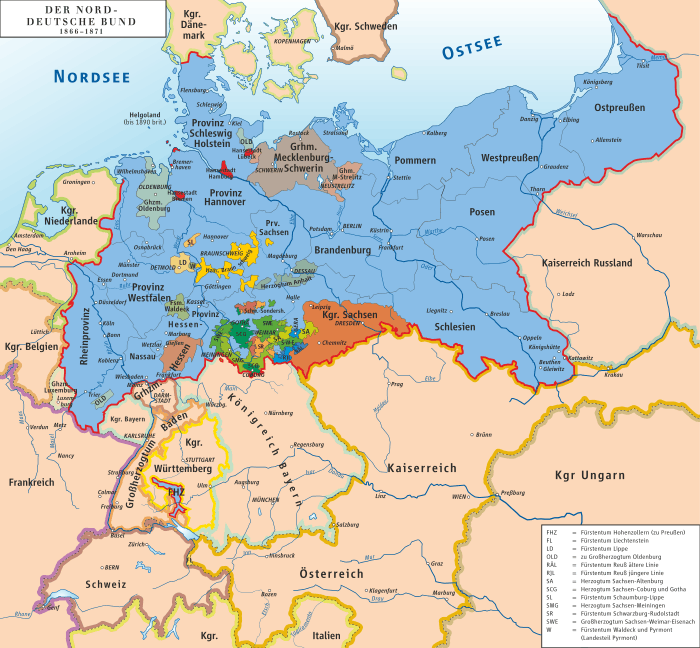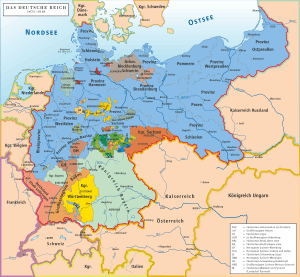Principality of Reuss-Gera
| Principality of Reuss-Gera | ||||||
| Fürstentum Reuß-Gera | ||||||
| ||||||
| ||||||
| Motto Ich Bau Auf Gott "I build on God" | ||||||
| Anthem Heil unserm Fürsten, Heil! "Hail to our Prince, Hail!" | ||||||
.svg.png) Reuss Younger Line within the German Empire | ||||||
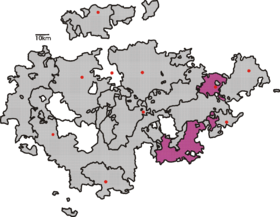 Reuss Younger Line within Thuringia | ||||||
| Capital | Gera | |||||
| Government | Principality | |||||
| Prince | ||||||
| - | 1806–1818 | Heinrich XLII | ||||
| - | 1818–1854 | Heinrich LXII | ||||
| - | 1854–1867 | Heinrich LXVII | ||||
| - | 1867–1913 | Heinrich XIV | ||||
| - | 1913–1918 | Heinrich XXVII | ||||
| Minister of State | ||||||
| - | 1825–1839 | Gustav von Strauch | ||||
| - | 1918 | Paul Ruckdeschel | ||||
| History | ||||||
| - | Established | 9 April 1806 | ||||
| - | Disestablished | 11 November 1918 | ||||
| Area | ||||||
| - | 1905 | 827 km² (319 sq mi) | ||||
| Population | ||||||
| - | 1905 est. | 144,570 | ||||
| Density | 174.8 /km² (452.8 /sq mi) | |||||
The Principality of Reuss-Gera (German: Fürstentum Reuß-Gera), after 1848 called Reuss junior line (German: Reuß jüngerer Linie), was a sovereign state in modern Germany, ruled by members of the House of Reuss. The Counts Reuss of Gera, of Schleiz, of Lobenstein, of Köstritz and of Ebersdorf, each became princes in 1806, and they and their reigning successors bore the title Prince of Reuss-Gera. One may also refer to them using their branch names (for example: Prince Reuss of Köstriz).
Territory
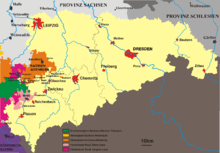
The territories of four separate branches of the Younger Line amalgamated between 1824 and 1848.
In 1905 the Principality of Reuss Younger Line had an area of 827 km² and a population of 145,000, with Gera as its capital.
In the aftermath of World War I the territory of the Younger Line merged with that of the Elder Line in 1919 as the Republic of Reuss, which in its turn became part of the new state of Thuringia on 1 May 1920.
The princely house
The House of Reuss practises an unusual system of naming and numbering the male members of the family, every one of which for centuries has borne the name "Heinrich". While most royal and noble houses give numbers only to the reigning head of the house, and that in the order of his reign, the Reuss Younger Line used a numbering sequence for all male family members which began and ended roughly as centuries began and ended. In consequence of this naming system, certain heads of the Reuss Younger Line have had the highest numbers attached to their name of any European nobility. Note also that the male children within a single nuclear family need not bear sequential numbers, as all members of the larger family use a common numbering system. For example, the sons of Prince Heinrich LXVII Reuss of Schleiz, in order of their births, used the names Heinrich V, Heinrich VIII, Heinrich XI, Heinrich XIV, and Heinrich XVI.
A notable member of this family, Augusta Reuss of Ebersdorf (1757–1831), became the maternal grandmother of Queen Victoria of the United Kingdom.
The designation "younger line" fell into abeyance in 1930; the "elder line" had become extinct as its last member, Heinrich XXIV, renounced his rights in 1918 and died unmarried in 1927.
Princes of Reuss-Gera (1806–1918)
- Heinrich XLII 1806-1818
- Heinrich LXII 1818-1854
- Heinrich LXVII 1854-1867
- Heinrich XIV 1867-1913
- Heinrich XXVII 1913-1918
Monarchy abolished 1918.
Heads of the House of Reuss
- Heinrich XXVII 1918-1928 (became "Prince Reuss" on the death of the last Prince of the Elder Line)
- Heinrich XLV 1927-1945/1962 (went missing in 1945, declared dead in 1962)
- Heinrich IV 1962–2012
- Heinrich XIV 2012-
- Heir: Heinrich XXIX Reuss
Other notable figures
- Princess Augusta Reuss of Köstritz (1822–1862)
- Prince Heinrich XXIV Reuss of Köstritz (1855–1910), composer
- Princess Eleonore Reuss of Köstritz (1860–1917), Tsaritsa of Bulgaria
- Prince Heinrich XXXII Reuss of Köstritz, assumed successor to Wilhelmina of the Netherlands until 1909.
- Princess Magdalena Reuss of Köstritz - wife of Prince Hubertus of Prussia
| |||||||||||||||||||||||||||||
| |||||||||||||||||||||||||||||||||||||||||||||||||||
| |||||||||||||||||||||||||||||||||||||||||
| ||||||||||||||||||||||||
| ||||||||||||||||||||||||||||||||



